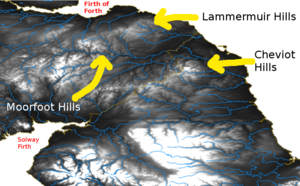Moorfoot Hills facts for kids
The Moorfoot Hills are a group of hills located south of Edinburgh in central Scotland. They are part of a larger area called the Southern Uplands.
Contents
What's in a Name?
The name Moorfoot has a long history! It was first written down as Morthwait way back in 1142.
The second part of the name, -foot, comes from an old language called Old Norse. In Old Norse, þveit meant "a clearing," "a meadow," or "a paddock."
The first part, Moor-, could come from either Old Norse mór or Old English mōr. Both of these words mean "moor" or "heath," which describes open, wild land.
How the Hills Were Formed
The Moorfoot Hills are made up of different types of rock, mainly wacke and siltstone. These rocks were formed a very, very long time ago!
Some of the rocks were created during the Ordovician period, which was about 485 to 443 million years ago. Other rocks formed during the Silurian period, which followed the Ordovician.
These hills were shaped by huge forces in the Earth's crust. Giant cracks in the ground, called faults, helped lift and move the rocks. These faults are linked to the closing of an ancient ocean called the Iapetus Ocean.
After the last ice age, which ended thousands of years ago, thick layers of peat started to grow. You can find a lot of peat on the flat tops of hills like Blackhope Scar.
Exploring the Moorfoot Hills
The Moorfoot Hills stretch from Peebles in the Scottish Borders up towards Tynehead in Midlothian. The very highest point in the Moorfoot Hills is a peak called Windlestraw Law, which stands at 659 metres (about 2,162 feet) tall.
Some parts of the Moorfoot Hills are special protected areas. They are called a Special Area of Conservation because they are important for nature.
Here are some of the tallest hills in the Moorfoot range:
| Hill Name | Height (metres) |
|---|---|
| Dundreich | 623 |
| Jeffries Corse | 613 |
| Bowbeat Hill | 626 |
| Blackhope Scar | 651 |
| Whitehope Law | 623 |
| Bareback Knowe | 656 |
| Windlestraw Law | 659.2 |
Wind Power in the Hills
The Moorfoot Hills are also home to the Bowbeat Wind Farm. This wind farm has 24 large wind turbines. These turbines are located between Bowbeat Hill, Blackhope Scar, and Dundreich Hill.
The Bowbeat Wind Farm was finished in September 2002. When it was built, it was the biggest wind farm in Scotland! It helps create clean energy for people to use.


